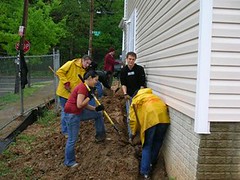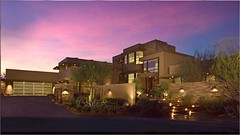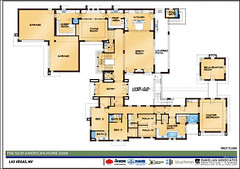The two Americas on display in DC and Vegas houses

Posted February 10, 2009 at 1:32PM
I was struck by two hugely contrasting stories in Sunday's Real Estate section of The Washington Post. If you want evidence that John Edwards's "two Americas" campaign theme had substance behind it, you need look no further.
 The first story was uplifting. Barbara Ruben highlighted the rising interest in Habitat for Humanity's local programs to provide affordable housing to DC residents in the distressed economy. Ruben reports that the homebuilding charity is seeing twice the number of people interested in finding homes at DC-area meetings as in the recent past. Unfortunately, Habitat has also been hurt by the economic downturn, with corporate donations suffering a sharp decline. But individual donations and volunteer participation are increasing, and the organization's local programs remain relatively strong. Even Vice President Biden, on the day before his inauguration, helped hang drywall in one of Habitat's new homes in northeast Washington.
The first story was uplifting. Barbara Ruben highlighted the rising interest in Habitat for Humanity's local programs to provide affordable housing to DC residents in the distressed economy. Ruben reports that the homebuilding charity is seeing twice the number of people interested in finding homes at DC-area meetings as in the recent past. Unfortunately, Habitat has also been hurt by the economic downturn, with corporate donations suffering a sharp decline. But individual donations and volunteer participation are increasing, and the organization's local programs remain relatively strong. Even Vice President Biden, on the day before his inauguration, helped hang drywall in one of Habitat's new homes in northeast Washington.
Dennis Smyth, interim executive director for the charity's DC affiliate, told Ruben that Habitat homes going up around the Washington area are "designed not only to provide shelter but also to integrate green technology and reduce the effects of foreclosures on neighborhoods."  It's great, of course, to see Habitat pursuing green, urban projects. At the beginning of the decade, Habitat had a reputation for building on the fringe and actually opposed smart-growth ballot initiatives in Arizona and Colorado on the basis of a then-popular myth that growth measures would make land and homes less affordable. Since then the Sierra Club and other environmental organizations have made efforts to team up with Habitat on joint strategies and affordable projects that also meet smart location standards.
It's great, of course, to see Habitat pursuing green, urban projects. At the beginning of the decade, Habitat had a reputation for building on the fringe and actually opposed smart-growth ballot initiatives in Arizona and Colorado on the basis of a then-popular myth that growth measures would make land and homes less affordable. Since then the Sierra Club and other environmental organizations have made efforts to team up with Habitat on joint strategies and affordable projects that also meet smart location standards.
While the organization's homes are traditionally new, single-family models, its northern Virginia affiliate is now building multi-family condos in the DC suburbs and, in nearby Montgomery County, Maryland, Habitat has partnered with local government to purchase and resell already-built, foreclosed properties. Ruben reports that almost all of the work on the houses is done by volunteers and home recipients, who must meet income requirements, clean up their credit, and take homeownership classes. Most Habitat homeowners get 25-year mortgages with no interest and pay about 30 percent of their monthly income on their mortgages. Ruben's article has some very warm personal anecdotes from new owners of Habitat properties, and I recommend it.
As for the other story in Sunday's paper, how about an 8,816-square-foot house in the desert, 30 miles from Las Vegas?  This, according to the National Association of Homebuilders, is its showcase product, "the new American home." The price tag? Four to five mil. Economic downturn? What economic downturn? Sprawl, anyone? Why worry? It's got green technology, apparently.
This, according to the National Association of Homebuilders, is its showcase product, "the new American home." The price tag? Four to five mil. Economic downturn? What economic downturn? Sprawl, anyone? Why worry? It's got green technology, apparently.
OK, I know there is a high-end market and, to an extent, there's nothing wrong with that. And, as the Post's Katherine Salant reports, the desert show home has very nice architecture - which, at the price, one would certainly hope it would. But this is the organization's signature communications effort, in the middle of the worst recession we have seen in over 70 years.  And in a global warming crisis, there is nary a mention of the impacts of the total automobile dependence. Here is a bit from the New American Home website:
And in a global warming crisis, there is nary a mention of the impacts of the total automobile dependence. Here is a bit from the New American Home website:
"The home, which is both a show house and a for-sale product, will remain open as a model for 18 months after the show. The home builder's target demographic will be people looking to buy their second, third or fourth home who are interested in a luxury home with a Nevada address that is minutes from the action on the strip. The community will be marketed heavily through luxury lifestyle media across the United States and around the world."
There is a lot on the website about the green technology incorporated into the design by the builder, Blue Heron, and the architects, Danielian Associates. Good for them. But isn't that sort of like improving the gas mileage on a Hummer? It's still a Hummer, no? Is this sort of conspicuous extravagance, spreading sprawl across the desert, really the most important and relevant statement you can make to the American public in February of 2009?
Two Americas, indeed.